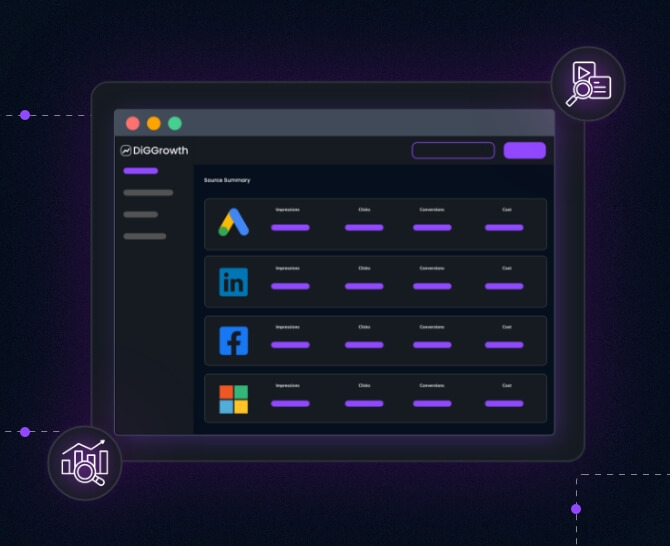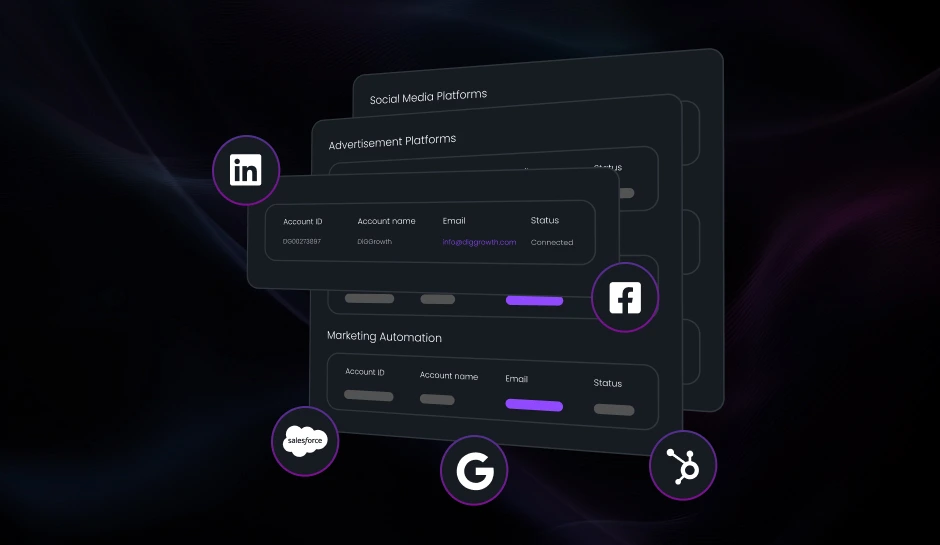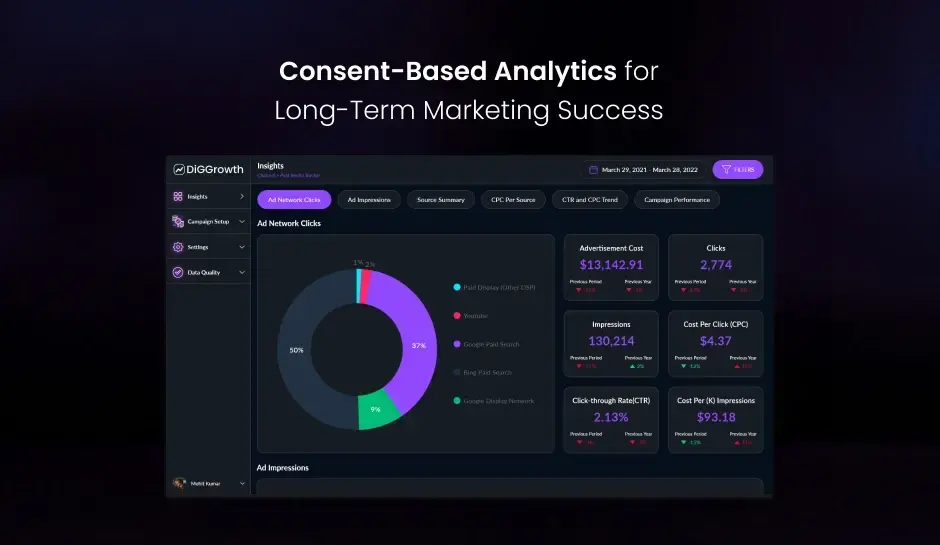
Best Winning B2B Campaigns You Need to Know
Harnessing the power of marketing analytics is essential for B2B marketers aiming to create winning campaigns. In this blog post, we have covered the whole nine yards of marketing analytics, its benefits, best practices, and how to implement it to create solid B2B marketing campaigns.
In today’s highly competitive business landscape, B2B marketers are constantly searching for effective strategies to stand out and drive success. The advent of marketing analytics has revolutionized the way businesses approach their campaigns.
By leveraging data and insights, marketers can make informed decisions, optimize their efforts, and ultimately create winning B2B campaigns.
In this blog post, we will explore the power of marketing analytics and how it can be harnessed to drive success in B2B marketing.
Understanding Marketing Analytics
Marketing analytics involves the collection, measurement, analysis, and interpretation of marketing data to gain valuable insights into customer behavior, campaign performance, and overall marketing effectiveness. With marketing analytics, you can shine a light on the hidden patterns and trends within your data, allowing you to make informed decisions and create winning marketing strategies.
In this data-driven world, a plethora of marketing analytics tools awaits you. These tools are like trusty companions, each with its unique abilities to analyze different aspects of your marketing efforts.
From web analytics that provide insights into website traffic and user behavior to social media analytics that unveil the impact of your social media campaigns, these tools hold the key to unlocking the secrets hidden in your marketing data.
Benefits of Marketing Analytics for B2B Marketing Campaigns
Let’s now explore the hidden treasures that marketing analytics can bring to your B2B marketing campaigns.
- Data-Driven Decision-Making:
- Identifying Your Ideal Customer:
- Campaign Optimization:
- Measuring Success:
With marketing analytics as your compass, you can navigate your marketing campaigns with precision. By analyzing data, you gain a deeper understanding of your customers, their preferences, and the most effective channels to reach them. Armed with this knowledge, you can make data-driven decisions that lead to increased engagement, conversions, and ultimately, sales.
In the vast ocean of potential customers, finding your ideal target audience can feel like searching for a needle in a haystack. But fear not! Marketing analytics can be your magnetic force, helping you attract the right customers. By analyzing customer demographics, preferences, and past behavior, you can create detailed buyer personas that paint a vivid picture of your ideal customer. This insight allows you to tailor your marketing messages and strategies to resonate with your audience, increasing the chances of capturing their attention and loyalty.
A race car driver knows that every second counts on the track. Similarly, every click, impression, and conversion matters in your B2B marketing campaigns. Marketing analytics provides you with a dashboard of performance metrics, enabling you to track and analyze the effectiveness of your campaigns in real-time. With this knowledge in hand, you can optimize your campaigns, fine-tuning your messaging, targeting, and timing for maximum impact. Just like a skilled mechanic fine-tunes a race car for peak performance, marketing analytics empowers you to optimize your campaigns for optimal return on investment (ROI).
As a B2B marketer, you need to demonstrate the value of your marketing efforts to key stakeholders. Marketing analytics acts as your scorecard, allowing you to measure and report on the success of your campaigns. By tracking key metrics such as conversion rates, customer acquisition costs, and customer lifetime value, you can showcase the tangible impact of your marketing activities. This data-driven proof of success strengthens your position within the organization and helps secure resources for future campaigns.
Implementing Marketing Analytics into Your B2B Marketing Campaigns
Now that we’ve glimpsed the wonders marketing analytics can unveil, let’s embark on the quest to implement it effectively into your B2B marketing campaigns. Consider these steps as your roadmap to success:
- Setting Goals and KPIs:
- Identifying Relevant Metrics:
- Integrating Marketing Analytics Tools:
- Regular Analysis and Optimization:
Just as an explorer sets a destination before embarking on a journey, you must define clear goals and key performance indicators (KPIs) for your marketing campaigns. Are you aiming to increase lead generation, boost website traffic, or improve conversion rates? By establishing measurable objectives, you create a benchmark against which you can evaluate your marketing analytics efforts.
In the vast landscape of marketing data, not all metrics are created equal. It’s essential to identify the metrics that align with your goals and provide meaningful insights. Whether it’s website traffic, social media engagement, or email click-through rates, choose the metrics that paint a clear picture of your campaign’s performance.
Assemble your arsenal of marketing analytics tools, selecting the ones that align with your objectives and provide the necessary data insights. Integrate these tools into your existing marketing infrastructure, ensuring a seamless flow of data and information.
As you set sail on your marketing voyage, remember that the sea is ever-changing. Regularly analyze your data, keeping a watchful eye on the metrics that matter most. Adapt your strategies, refine your messaging, and optimize your campaigns based on the insights gained from your marketing analytics. Continual analysis and optimization are the wind in your sails, propelling you toward marketing success.
Best Practices for Successful Implementation
As you embark on the exciting adventure of implementing marketing analytics into your B2B marketing campaigns, it’s essential to arm yourself with the best practices that will guide you to triumph. Let’s explore some key considerations and tips to ensure a successful implementation.
- Choosing the Right Marketing Analytics Tools:
- Defining Key Performance Indicators (KPIs):
- Data Collection and Integration:
- Data Quality and Cleansing:
- Iterative Approach and Continuous Improvement:
- Collaboration and Communication:
It’s crucial to choose the marketing analytics tools that align with your specific business needs. Consider factors such as your budget, the complexity of your campaigns, and the level of technical expertise available in your team. Whether you opt for comprehensive all-in-one platforms or niche tools for specific analytics needs, prioritize usability, scalability, and integration capabilities.
To navigate your marketing journey successfully, you need a compass that points towards success. Defining clear and relevant KPIs ensures that you’re measuring what truly matters to your business objectives. Are you seeking to increase conversions, improve customer engagement, or boost brand awareness? Identify the KPIs that align with your goals and make them the guiding stars in your analytics implementation.
Picture data as the fuel that powers your marketing engine. Ensure that you have a robust data collection strategy in place to capture the right information from various sources. This may involve integrating your website analytics, CRM system, email marketing platforms, and other relevant data sources. The seamless flow of data across platforms creates a holistic view that enables more accurate analysis and insights.
You must nurture and maintain your data to ensure its quality. Implement data cleansing processes to eliminate duplicates, incorrect entries, and inconsistencies. Regularly monitor data quality to ensure accuracy and reliability. Remember, clean data leads to sound decision-making and actionable insights.
Rome wasn’t built in a day, and neither is a data-driven marketing strategy. Embrace an iterative approach, continuously monitoring, analyzing, and optimizing your campaigns based on the insights gained from marketing analytics. Treat every campaign as a learning opportunity, applying the lessons learned to future endeavors for ongoing improvement and success.
Just as a well-coordinated crew can sail a ship to victory, effective collaboration and communication are key to a successful analytics implementation. Foster cross-functional collaboration between marketing, sales, IT, and other relevant teams to ensure alignment and a shared understanding of goals and processes. Establish regular reporting mechanisms to keep stakeholders informed and engaged throughout the implementation journey.
With these best practices as your guiding compass, you’re ready to set sail on a successful marketing analytics implementation. Choose the right tools, define clear objectives, nurture your data, invest in talent, and embrace a culture of continuous improvement.
By incorporating these tips into your journey, you’ll navigate the complexities of marketing analytics with confidence, unlocking new levels of success for your B2B marketing campaigns.
Limitations of Marketing Analytics and Their Solutions
Like any adventure, the path to success in marketing analytics is not without its challenges and limitations. Here are some obstacles you may encounter along the way:
- Data Quality and Accuracy Issues:
- Complexity of Data Analysis:
- Resource Constraints:
Just as a map with incorrect markings can lead you astray, inaccurate or incomplete data can misguide your marketing decisions. Ensure that your data sources are reliable, clean, and comprehensive to ensure accurate insights.
The world of marketing analytics can be as intricate as a labyrinth. Analyzing large volumes of data and extracting meaningful insights requires expertise and time. Consider partnering with experts or leveraging user-friendly analytics platforms to simplify the process.
The quest for marketing analytics mastery requires time, money, and skilled personnel. Small businesses or those with limited resources may face challenges in fully embracing marketing analytics. However, with careful planning and prioritization, even modest efforts can yield significant results.
Performance Tracking and Analytics in B2B Campaigns:
Tracking and analyzing the performance of your B2B campaigns is crucial for success. By measuring campaign performance using metrics such as conversion rates, click-through rates, lead generation, and return on investment (ROI), you gain valuable insights into the effectiveness of your marketing efforts.
With performance tracking and analytics, you can identify what is working well and what needs improvement. By understanding which campaigns are generating the most leads and conversions, you can allocate your resources effectively and optimize your strategies for maximum results.
Sales Enablement in B2B Campaigns
Effective B2B campaigns require collaboration with sales teams to ensure lead conversion success. By providing necessary tools, content, and resources, sales enablement plays a crucial role in driving conversions:
- Sales Training
- Collateral Development
- Lead Handover Processes
Equipping sales teams with the knowledge and skills they need to effectively communicate the value proposition and benefits of the product or service being promoted.
Creating compelling sales materials such as brochures, sales sheets, and presentations that sales representatives can use to engage prospects and close deals.
Establishing efficient processes for transferring leads from marketing to sales, ensuring a smooth transition and minimizing the risk of leads being lost or mishandled.
By prioritizing sales enablement in B2B campaigns, businesses can enhance their sales effectiveness and maximize the return on investment for their marketing efforts.
Account-based Sales Development (ABSD) in B2B Campaigns
Account-based Sales Development (ABSD) is a critical component of successful B2B campaigns. By complementing account-based marketing efforts with personalized outbound sales strategies, companies can effectively engage and nurture key accounts, strengthening both marketing and sales alignment.
- Personalized Outbound Sales Strategies:
- Strengthening Marketing and Sales Alignment
- Social Media Marketing in B2B Campaigns:
With ABSD, companies can tailor their sales approach to each individual account. By understanding the unique needs and pain points of key accounts, sales teams can deliver targeted messages that resonate and drive conversions.
ABSD bridges the gap between marketing and sales, ensuring both teams are working towards the same goals. By collaborating on messaging and strategies, marketing and sales can create a seamless customer experience that boosts conversion rates and revenue.
– Utilizing social media platforms to increase brand visibility and engage with target customers
– Creating compelling content and running targeted ads on social media
– Participating in industry-related discussions to build brand awareness and drive website traffic
Email Marketing in B2B Campaigns:
How email campaigns play a crucial role in B2B marketing
Tailored email campaigns for prospect outreach, lead nurturing, content sharing, and product/service promotion.
Leveraging email automation and personalization for effective B2B campaign management
- Event Marketing in B2B Campaigns:
- Importance of participating:
Participating in industry events, trade shows, webinars, and conferences can greatly impact the success of B2B campaigns.
Showcasing products/services to a targeted audience
Networking with potential clients and industry influencers
Generating leads through face-to-face interactions
Conclusion
With marketing analytics as your guiding light, you can make data-driven decisions, identify your ideal customers, optimize your campaigns, and measure your success. Embrace the power of marketing analytics, and unlock the door to a world of endless possibilities for your B2B marketing campaigns.
Ready to Harness the Power of Marketing Analytics? Let’s Talk!
and propel your B2B marketing campaigns to new heights, our marketing scientists would love to pitch in. Just write to us at info@diggrowwth.com and we’ll get right back to you.
Ready to get started?
Increase your marketing ROI by 30% with custom dashboards & reports that present a clear picture of marketing effectiveness
Start Free Trial
Experience Premium Marketing Analytics At Budget-Friendly Pricing.

Learn how you can accurately measure return on marketing investment.
Additional Resources
Integrating Data from Different Channels for a Holistic View of Your Marketing Performance
Who's your ideal customer? Where do they come...
Read full post postGet Your Channels to Play Nice: Integrated Data for Smarter Marketing
If you’re a savvy marketer, you’re living in...
Read full post postConsent-Based Analytics for Long-Term Marketing Success
As marketers, we want our customers to perceive...
Read full post post Manreet Khara
Manreet Khara 

